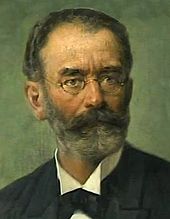Wilhelm Mill
Wilhelm Mühle (born September 21, 1845 in Kulm , Bohemia , Austrian Empire , † September 15, 1908 in Temesvár , Kingdom of Hungary , Austria-Hungary ) was a landscape architect and rose breeder .
Life
Mühle received his education at Bohemian and German schools. In 1876 Mühle opened a gardening business in the Temesvár district of Erzsébetváros ( Elisabethstadt in German ), where the Casa Mühle ( House Mühle ) still exists on today's Bulevardul Mihai Viteazu . He also bought a shop in today's Strada Alba Iulia , the Casa cu flori (German House of Flowers ). From here he successfully sold flowers and ornamental plants in Southeastern Europe , sometimes as far as Vienna or Budapest .
![]()
From September 1893 to July 1895, Mühle was the publisher of the then bimonthly "Rose newspaper", the German edition of the Hungarian rose magazine Rózsa Ujság (1889-1896).
The Wiener Illustrierte Garten-Zeitung published a report on Wilhelm Mühle's botanical study trip to North and South America in the August – September issue of 1899 . In 1906, Wilhelm Mühle was mentioned in the Austrian garden newspaper with the breeding of a tea rose.
Wilhelm Mühle was, alongside Wenceslas Franz Niemitz, one of the city's most important florists ; Both were entrusted with the planning and execution of the Royal Rose Garden , which was inaugurated on July 19, 1891 and was the predecessor of today's Parcul Rozelor . Through his work, he made Temesvár known as the city of roses at the beginning of the 20th century .
Wilhelm's son, Árpád Mühle , continued his father's business after his father's death. 13 new rose varieties created by him have been registered at international level. With Árpád, the park developed into the largest rosarium in Southeastern Europe in the interwar period with over 1400 types of roses from Europe , America and Asia .
Honors
Wilhelm Mühle, who has made a contribution to the creation of the city's parks, was posthumously made an honorary citizen of the city of Timisoara on August 2, 2013 . The unveiling of his bust in the rose garden took place on the same day.
literature
- Anton Peter Petri : Biographical Lexicon of the Banater Deutschtums , Marquartstein, 1992, ISBN 3-922046-76-2
Web links
- CasaCuFlori.ro ( Flash ; 1.4 MB), Casa Cu Flori: Biography of Mühle , in English
Individual evidence
- ↑ Welt-der-Rosen.de , Rosenpresse - magazines and newspapers for friends of roses
- ^ BKGE: German-language sheets: SZ. Federal Institute for Culture and History of Germans in Eastern Europe, accessed on August 30, 2014 (entry 1035).
- ↑ KurtCulbertson.blogspot.com , Kurt Culbertson: Landscape and Garden Art : The German Influence in the Development of Landscape Architecture in America , in English
- ^ Horticultural Society in Vienna: Österreichische Garten-Zeitung, Volume 1 . Kaiserl. Royal Gartenbau-Gesellschaft, Vienna 1906, p. 348 .
- ↑ Temeswar.Diplo.de , German Consulate in Timisoara, press evaluation August 10-16, 2009, agenda: In search of the roses
- ↑ banater-schwaben.org , Clara-Liselotte Basica: Bust unveiled in the Temeswar rose garden.
Remarks
- ↑ The house still houses a flower shop today (as of December 2009) and the upscale restaurant Casa cu flori .
| personal data | |
|---|---|
| SURNAME | Mill, Wilhelm |
| BRIEF DESCRIPTION | Landscape architect, rose grower |
| DATE OF BIRTH | September 21, 1845 |
| PLACE OF BIRTH | Kulm , Austrian Empire |
| DATE OF DEATH | September 15, 1908 |
| Place of death | Temesvár , Kingdom of Hungary , Austria-Hungary |

